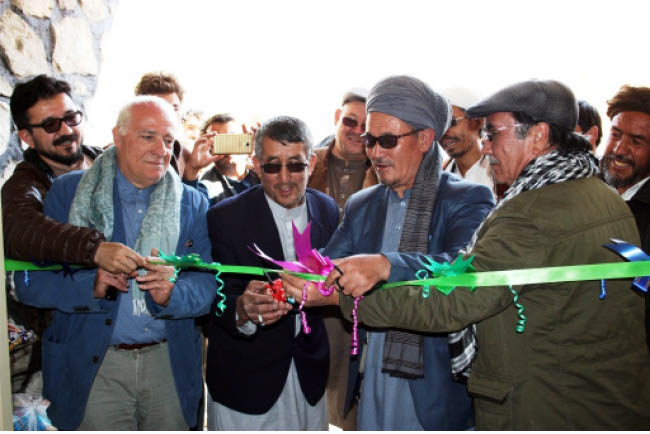Repressing his breath like a white dove, he focused his penetrating look at tape, which was hanged before the building gate. Gliding the scissor’s tail on the flamboyant tape, a burst of applause was heard and the 11th bell rang. She, who never knelt under a roof or sat on a chair for learning, offered a bouquet of wild flower – which was collected in the morning with her swollen hands from the surrounding hills of the school – to an old man who still held one head of the tape. Having a mild smile on her lip like a rose in bloom, Nikbakht gazed with her almond-like eyes to the old man’s blue eyes and said with childish accent, “Uncle! Uncle! I am pleased that you have built school for us and we will sit on the chair and study our lessons at school from now onward!”
With his compelling voice, Marco Neyado, a 64-year-old foreign man, congratulated the school, which is located on the frontier provinces of Bamyan, Daikundi and Ghor, to the audience who gathered at the inaugural ceremony of Myan Kawak school building.
Shaking hands to the sunburnt men and women, who seemed to have suffered hunger for years, he said, “People can share the happiness of their life. I have been lucky in my life and wanted to share my happiness with you as you live in the most distant part of Bamyan.”
Marco thought of sharing happiness when he visited Band-e-Amir in 2004 on the 50th birthday anniversary of her wife, Maria. The memorable celebration was provided by Maria’s friend Philopo, one of the UN’s staff.
The head of Shuhada Organization and Arghosha Committee’s co-worker Jawad Wafa who befriended the old man and his colleague Mustafa Husaini said, “Marco Neyado is a journalist. He is from the Milano City of Italy and has a male child. This three-membered family lives in London now and shared his happiness with you within last 11 years.” Being influenced by the wrinkled faces, swollen hands, and hopeful eyes of the locals, Wafa added, “Marco established his first school in 2005 in Arghosh area of Band-e-Amir, in the frontiers of Samangan, Sare-Pul and Bamyan, where the government’s footstep is still lacking.”
Marco who was distributing books and pens to the children, who circled him, said with a big smile, “Arghosha is a small Committee with only 4 members who are all Italian and members of a single family. We established this Committee to build schools in most distant places.” Glancing at the blue sky of Myan Kawak and breathing a sigh of relief, he added, “Our family along with my friend Philipo struggles to build schools to bring smile on the lips of Bamyan children through collecting cent, dollar cent from about 40 or 50 of my friends who are all kind-hearted and want to see others fine and happy, too.”
Pointing to the high mountains of Baba, Band-e-Pitau, Aros, and meandrous valleys of Bamyan, the old man said, the area of Arghosha is not only the name of our Committee, but Arghosha also means very distant school – i.e. the Committee of very distant school.” After a short pause, Marco continued, “Today, we have come here to submit this school, as we built it in the most distant place, to the Department of Education, local elders and students who studied in the sun and on the soil up to now.”
One of the Myan Kawak’s elders Ghulam Haider asked eagerly how many schools this Italian journalist had built in Bamyan and how many students studied there. “This is the 11th schools of Mr. Marco and Arghosha Committee which has been inaugurated today,” replied Mohammad Ayob Amiri, head of Bamyan’s Education.
Shortly pointing out the Education in Bamyan in the past, Amiri said, “The schools have been built earlier by the financial support of Marco’s family are: Arghosha, Sare-Qul, Komity, Joula, Chehardeh, Resalat, Zarin, Dar-e-Ali, Ghorab and Sesarab. Overall, 3947 students are taught by 114 teachers in these 11 schools – small girls form most of the students.”
A 55-year-old man Hasan Bik, a kind-hearted person from Yakaw Lung District, nodded and said, “I have heard earlier that a country’s development is measured on the basis of a country’s development in education. Now we have seen that wherever this gentleman built school, road and clinic were immediately built there, too.” Clearing his throat and pointing to the highness of Arghosha, he added, “Since there was no school, the residents of that area were deprived to the extent that there was no road even for bikes. After the establishment of school, however, the residents of Arghosha own road, clinic, electricity and drinking water well.”
Bamyan is a quiet province, depleted of violence and replete with nice and attractive nature. Marco, who comes here annually along with his family for submitting his school, said, “The security, peace, civility and beauty of this province prompted me to spend more than one million and eight thousand US dollars on building schools.”
It comes as Mr. Marco’s other projects in Bamyan includes scholarship for ten girls to universities in Kabul, the establishment of four libraries, establishment of courses for teachers’ capacity buildings, literacy, computer and English courses, sheep farm projects and women’s empowerment programs which have been implemented by Shuhada Organization. Building schools in the farthest areas of Bamyan province by a foreign journalist has not been known to the government. The ground has been paved for other developing projects such as road construction, clinic, water channels and access to electricity and internet.

